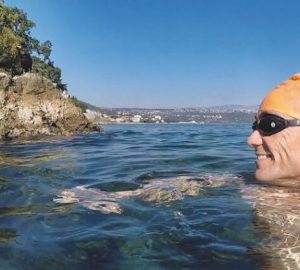A swim well executed – another way to think about swimming goals
Swim coach Dan Abel (Fit & Abel) took part in the April 2014 running of the State King of the Bays swim, in Auckland, New Zealand, and used the occasion to reflect on swimming goals and the question of what makes a good swim.
It’s nice to have the confidence and attitude that enables an open water swimmer to be able to go into an event and enjoy it no matter what the weather. It is awesome when the weather plays the game and provides amazing swim conditions. Such was the case for the eleventh State King of the Bays Swim, the final race in the State New Zealand Ocean Swim Series that took place on Saturday 12 April. Bright blue skies, warm air and water temperatures and a gentle hint of breeze greeted participants.
As usual race director Scott Rice and his team at Quantum Events provided slick organisation – but they’ve had 11 years to get it right. 1600 excited swimmers lined the beach in Auckland, New Zealand, at the Milford domain for the pre-race briefing and start. Tiered start waves based on predicted swim times ensured the beach starts weren’t too daunting.
I want to tie my commentary into H2Open editor Simon Griffiths’s recent blog post on the “ultimate swimming goal” as this year I took a new, unique and personal approach to my own swim.
An ultimate swim goal, I would argue, is a dynamic beast. Last year I was heavily involved in training for a Cook Strait swim. This year I have been focussed on my other passion: swim coaching. Observing and coaching has meant my own swimming has taken a back seat. Therefore I used a change of approach for this year’s King of the Bays. If I had approached the swim in the same way as last year (when I was extremely swim-fit) I would have been very concerned as I had only completed around 25 per cent of the training volume compared to 2013. It would be difficult to match my performance and therefore the likelihood of “success” (defined as beating last year’s results) was unlikely.
I therefore had to choose a new goal through which to define success and decided I would swim the best I could within the bounds of the preparation that I had completed. This approach allowed me to swim slower this year yet to still feel like I had a successful and satisfying swim.
I still started alongside the faster yellow-hat swimmers, which include elite swimmers such as Australians Rhys Mainstone and Mel Gorman and New Zealand open water champion Kane Radford. At the start I jogged in with the third row of swimmers into the gentle surf (rather than fighting my way to the front). I waded longer and duck dived further rather than immediately starting to race frantically. I didn’t sprint to the first turn buoy but enjoyed the feel of the salt water, the warmth of the sunlight, the view of the bottom below and even took the time to flash a cheeky smile at some of the safety crew. I gave my body a chance to warm up until I passed the yellow 980m marker then I focussed on maintaining a consistent pace. I also had time to mentally draft this article and maybe stopped sighting for a bit and drifted off-course just slightly. I caught myself and got back into consistent sighting. I passed buoy number six of eight and knew it was time to build on the pace toward the finish of the 2.8km swim. There were plenty of swimmers around me but plenty of space as well.
The finish line required a short run up the beach. I found my legs worked pretty quickly once the cheers of a substantial crowd hit my ears. Then it’s smiles, high-fives and a fun social atmosphere with swimmers from around the country and a few gasps on seeing some of the times produced by the top open water swimmers.
For me having a goal of swimming the best that my current training allowed enabled me to compete, challenge myself and, although not repeating performances of old, I still was able to feel the satisfaction of a swim well executed.






